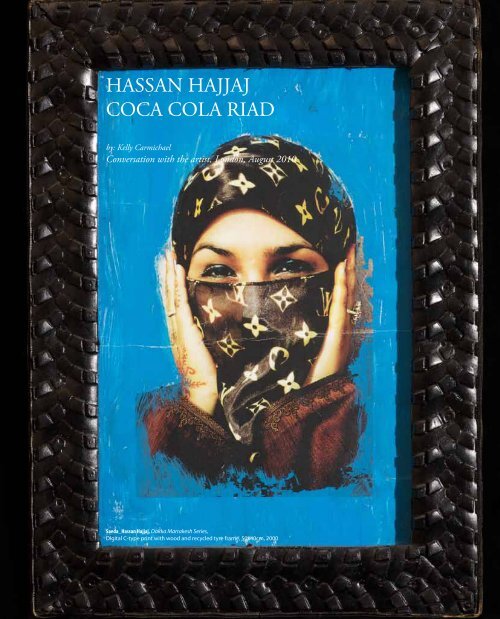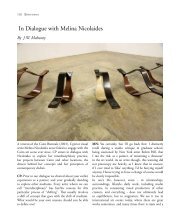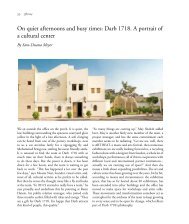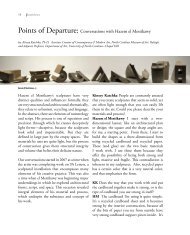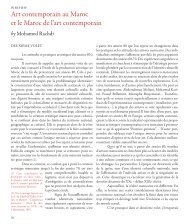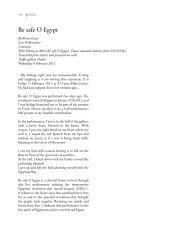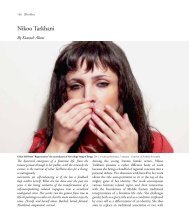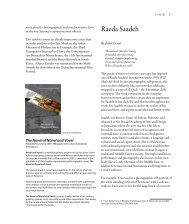HASSAN HAJJAJ COCA COLA RIAD - Contemporary Practices
HASSAN HAJJAJ COCA COLA RIAD - Contemporary Practices
HASSAN HAJJAJ COCA COLA RIAD - Contemporary Practices
Create successful ePaper yourself
Turn your PDF publications into a flip-book with our unique Google optimized e-Paper software.
158 Reviews<br />
<strong>HASSAN</strong> <strong>HAJJAJ</strong><br />
<strong>COCA</strong> <strong>COLA</strong> <strong>RIAD</strong><br />
by: Kelly Carmichael<br />
Conversation with the artist, London, August 2010<br />
Saeda_Hassan Hajjaj, Dakka Marrakesh Series,<br />
DIgital C-type print with wood and recycled tyre frame, 50x40cm, 2000
Sometimes you meet an artist and it’s impossible<br />
to separate their practice from their life: the<br />
approach is the same, one reflects the other<br />
and somehow these two strands strengthen the<br />
whole. Arriving at Hassan Hajjaj’s showroom<br />
situated in London’s East End you’re immediately<br />
surrounded by the iconic items of his practice.<br />
Hung from the ceiling, bursting out of shelves<br />
and stacked against walls are lamps, tables,<br />
clothing, photographs, plastic coca cola crates,<br />
empty packaging, boldly printed fabrics and<br />
mats. These everyday objects are the building<br />
blocks of a practice that stretches across fashion,<br />
design, photography and installation, one<br />
capturing the vibrant atmosphere and upbeat<br />
rhythm of the artist’s homeland of Morocco.<br />
Incredibly eclectic, brimming with colour,<br />
warm, engaging, playful, streetwise and witty –<br />
welcome to the world of British-Moroccan artist<br />
and designer Hassan Hajjaj.<br />
Jumping between genres with the same energy<br />
and vibrancy he lives life, Hajjaj’s work reflects<br />
the living culture of Morocco. His materials<br />
come from the souk while inspiration, models<br />
and attitude are courtesy of the streets of<br />
Marrakesh. It would be impossible to imagine<br />
Hassan Hajjaj’s practice without the medina,<br />
the souk, the colours and enticing confusion<br />
of this ancient city. His works are not so much<br />
a reflection of Morocco but a distillation of its<br />
essence and its influences. For Hajjaj his practice<br />
is “a celebration of my culture – the smells, the<br />
sounds, the everyday objects, the foods, shapes<br />
and feel of this hot, sunny, noisy world.” When<br />
his family immigrated to London in the 1970s,<br />
the 14 year old was taken away from the colour<br />
and vibrancy of Morocco and plunged into a<br />
whole new set of surroundings. It’s tough when<br />
you’re a teenager who doesn’t speak English, is<br />
trying to fit in and “figure out what it means to<br />
Reviews<br />
159<br />
be a streetwise Moroccan kid in London”, but<br />
such circumstances teach you a lot about making<br />
opportunities and thinking on your feet. Hajjaj<br />
recalls the newness of everything he found –<br />
“Roxy Music, Rod Stewart, ska, the food, the<br />
clothes!” – with exhilaration, with the sense of<br />
someone who fried in the exoticism of a new<br />
set of pop culture references. Popular culture<br />
is Hassan Hajjaj’s pulse. His passion for the<br />
products, look, attitude and feel of the streets<br />
– Western or Moroccan – is clearly evident in<br />
his work, an astute combination of global urban<br />
culture and Middle Eastern clichés.<br />
Coming of age in London during the Punk era<br />
and birth of the clubbing scene gave Hajjaj a<br />
unique cultural playground. If, as Frank Zappa<br />
would have it, it’s true that “art is making<br />
something out of nothing and selling it”,<br />
Hassan Hajjaj might just be the man he had<br />
in mind. Variously a van driver, club promoter,<br />
restaurant designer and fashion store owner –<br />
selling luxury labels such as Vivienne Westwood<br />
and Galliano mixed in with cheeky Moroccan<br />
fakes – Hajjaj rode the cultural and economic<br />
wave of the times. His ability to spot and catch a<br />
trend just as it began to surface says much about<br />
the shrewd ‘street-wise Moroccan kid’ and many<br />
aspects associated with his earlier ventures are<br />
later incorporated and translated into his artistic<br />
practice. However it was his recycling of objects,<br />
the turning of discarded Coca-Cola crates with<br />
Arabic script and advertising signs into chairs<br />
and tables – a common practice in North<br />
Africa – that first launched Hajjaj as a designer.<br />
Reinventing and recasting these signifiers of<br />
culture and place with something of a Punk DIY<br />
approach, Hajjaj drew upon the familiarity of<br />
Moroccan brands and their logos and packaging<br />
reminiscent of the 1950s and 60s along with<br />
practices he rediscovered from childhood.
160 Reviews<br />
Hassan Hajjaj, Seating for Tea Room Installation, Similar for sale at his London showroom<br />
It’s hard to ignore that much of Hajjaj’s work<br />
involves the use of brands and logos and this is<br />
never more evident than in the Salon works – a<br />
glorious riot of colour, logo, reworked textiles<br />
and signage. Whether designer labels or his<br />
fascination with the retro look of Moroccan<br />
packaging, brands play an important role in<br />
Hajjaj’s work and he describes them as “playing<br />
a large part in influencing my perception of<br />
the world”1. Preparing items for a Salon to be<br />
installed in the upcoming Berlin exhibition ‘My<br />
Beautiful Rubbish’ when I visit his studio, Hajjaj<br />
shows me the objects he’s sending, all made<br />
1-Hassan Hajjaj Dakka Marrakesh, Hassan Hajjaj and Beyond Art Productions<br />
2008. Interview by Juliet Cestar<br />
from recycled, re-appropriated North African<br />
materials and overflowing with the vibrant<br />
packaging and typography used in North African<br />
and Middle Eastern commerce. Tins, beaten<br />
flat and pierced then shaped into traditional<br />
Moroccan-style lamps, their original printing<br />
still visible, advertise the baby milk formula,<br />
Nescafe or meat they once contained. Stools are<br />
made of large paint buckets covered with fabric<br />
carrying the Louis Vuitton logo while the legs<br />
of one low table are constructed from stacked<br />
Moroccan teapots and the top of another is a<br />
light-box advertising Fanta. Red Coca Cola<br />
crate bookcases, clothing made from empty<br />
flour sacks, Moroccan pouffees and cushions
of vibrantly coloured 1960s designs abound.<br />
Hajjaj conceives each Salon as an immersive<br />
and interactive social space. Tea and sweets are<br />
served with traditional Arabic hospitality while<br />
especially selected music, films and even Wi-<br />
Fi entertain visitors to the space. Conceived<br />
with the same careful and considered approach<br />
towards brand, content and atmosphere as<br />
the club nights he used to organize or the<br />
celebrated ‘Andy Wahloo’ restaurant he designed<br />
in Paris, each Salon bursts with the energy of<br />
global popular culture. The Western food and<br />
beverage logos that dominate our lives are well<br />
represented here, albeit in a distinctly Moroccan<br />
reincarnation, and often in Arabic script.<br />
Hajjaj’s blending, overlaying, re-creating and<br />
transforming of everyday objects and material<br />
means the term ‘multi-disciplinary’ falls short<br />
to accurately describe his technique. Perhaps<br />
‘mash-up’ is a better term, for it is this streetwise<br />
urban approach of overlaying items,<br />
influences and cultural signifiers that is evident<br />
in the Dakka Marrakesh exhibition of 2008 and<br />
later photographic series Kesh Angels (2010).<br />
Though already a celebrated designer, Dakka<br />
Marrakesh at Rose Issa Projects in London was<br />
the first outing of Hajjaj’s considerable body<br />
of photographic work. The images had been<br />
steadily building up since around 2000, but<br />
Hajjaj had chosen not to show them, saying<br />
the photographs were “initially too personal. I<br />
wanted to protect my friends and my culture.<br />
Design is fun, but for me photography is<br />
personal. Rose got the work, it felt ok to exhibit<br />
the images with her and in that context”. With<br />
a nod to both African studio photography,<br />
Arabic film posters of his childhood and the<br />
iconic look of international fashion magazines,<br />
the photographs of both bodies of work are<br />
Hassan Hajjaj, Kech Angels Series, Hassans Angels-Khadija,<br />
Metallic Lambda Print, wooden frame and soda cans, 135.9 x 93.4 cm, 2010<br />
Reviews<br />
161<br />
carefully stage-directed by the Hajjaj. Poses,<br />
costumes, props and backdrops form mini sets<br />
upon which theatrical narratives can be played<br />
out around the iconography of East meets West<br />
and contemporary culture and consumerism.<br />
Bringing his fashion background to both bodies<br />
of work led Hajjaj to design the clothing worn<br />
by models selected from the medina or who were<br />
already friends. Many images feature counterfeit<br />
logos of global giants Louis Vuitton and Nike<br />
alongside hybrid items designed by Hajjaj and<br />
richly patterned with polka dots, leopard print<br />
and camouflage. The works, some framed with<br />
old tires or collages of Moroccan packaging, are<br />
a fusion of cultures, influence and place. The<br />
collision of Western urban street fashion and
162 Reviews<br />
traditional Moroccan style in the earlier works<br />
culminate in the Louis Vuitton logo hijab or<br />
Nike babouche, all modeled in the nonchalant<br />
manner of fashion magazines. In these works<br />
faux Vuitton is quite literally part of the fabric<br />
of urban life. But while these images reflect<br />
the rampant consumerism and brand fetish of<br />
contemporary culture they also seem to fuel it.<br />
Hajjaj’s borrowing of the fashion shoot aesthetic<br />
– all glossy surfaces, street smart attitude and<br />
sass – whetting our appetite for more.<br />
Creating an unexpectedly rich and compelling<br />
narrative, the Kesh Angels series draws upon the<br />
biker culture of the young women of Marrakesh.<br />
Styled in strong colours and patterns and posed<br />
upon scooters and motorbikes, Hajjaj reflects<br />
the strength, spirit and street smarts of these<br />
women. While the biker girl look may be a rock<br />
song cliché summed up by a pair of jeans and<br />
a clingy t-shirt, these images have been recast<br />
in characteristic Hassan Hajjaj style. The Kesh<br />
Angels model colourful djellabah and veils of the<br />
artist’s own design, respecting tradition but also<br />
addressing the viewer with a confident, modern<br />
and independent manner. The urban street<br />
aesthetic and contemporary textiles teasingly<br />
subvert traditional attire and rework tired<br />
Hassan Hajjaj,Kesh Angels Series, Wink,<br />
metallic lambda print, wooden frame and kohl packaging, 91.8 x 63.7 cm, 2007
Hassan Hajjaj, Hassan Hajjaj, Shelving for Tea Room Installation<br />
Reviews<br />
163
164 Reviews<br />
clichés, becoming a theatrical device for Hajjaj<br />
to cast a flirtatious glance at his audience. Also<br />
addressing the politically charged symbol of the<br />
veil, Hajjaj playfully questions our perception<br />
of and obsession with stereotypes. The Kesh<br />
Angels may be djellabah clad, but their inner<br />
biker chick shines through. The juxtaposition of<br />
familiar components from contrasting cultures<br />
is further emphasized by frames that draw upon<br />
Moroccan packaging, forming a distinctive<br />
kind of Maghreb product placement. Again<br />
mixing and unifying elements of new and old in<br />
characteristic style, the frames are hand crafted<br />
from wood inlayed with various items – mini<br />
soft drink cans, boxes of matches, make up<br />
bottles, plastic blocks or little boxes of kohl –<br />
each is unique, integral to the overall work and<br />
responds in some way to the image it surrounds.<br />
Confessing that he “likes to play with the<br />
concept, likes to loosen up people’s ideas of<br />
what an Arabic woman looks like” Hajjaj often<br />
creates works and images that bring Western<br />
and Moroccan culture head to head. Previous<br />
photographs have drawn upon and reworked<br />
stereotypes such as the Odalisque, that 19th<br />
Century symbol of Oriental exoticism and<br />
passive femininity. A well-known work from<br />
2000, Ilham shows a woman recreating the<br />
standard odalisque pose, reclining on a sofa<br />
behind which Moroccan tiles in a geometric<br />
design cover the wall. However this woman<br />
looks directly at the viewer, engaging them with<br />
a confidence and presence that suggests we are<br />
more a guest in her space, perhaps her home,<br />
and that we are equally being observed. Hajjaj’s<br />
approach is to toy with the perceptions of Arabic<br />
culture and the relationship between East and<br />
West, recasting iconic images and allowing shafts<br />
of 21st century light to reenergize the encounter.<br />
While Hajjaj touches upon the politics of<br />
observation and there is obvious ground for<br />
evoking postcolonial debates in much of his<br />
photographic practice, it would seem that he is<br />
always careful to evoke a certain ambiguity in<br />
the work. Commenting that his images “can<br />
go either way” Hajjaj’s practice of inclusion<br />
and contrast rarely offers just one aesthetic or<br />
theoretical option. His works evoke numerous<br />
stereotypes and arguments, subvert just as<br />
many and playfully ask viewer to examine their<br />
own reactions. Toying with and questioning<br />
labels – literal or those imposed by history<br />
or culture – Hassan Hajjaj’s practice is full of<br />
images and situations that look familiar but on<br />
closer inspection disrupt what we thought we’d<br />
Hassan Hajjaj, Tabletops for Tearoom Installation
see. Turning Orientalist clichés on their head<br />
is a particular favourite, none more so than in<br />
two [insert ‘previously un-shown’ if we can use<br />
them here] photographs from 2008. The first<br />
image sees the Hajjaj staging a scene of dreamy<br />
Orientalist fantasy, but with a contemporary<br />
twist. Lying on a sofa, its base made from the<br />
artist’s trademark red Coca Cola crates, we find<br />
a man at rest. Seated on the ground, beautiful<br />
women surround him, one wearing a kaftan<br />
drenched in Louis Vuitton logos. The second<br />
image capsizes this Orientalist illusion – the<br />
man is now standing, at work it seems, serving<br />
the women while they relax. One of them has<br />
even stolen his sofa.<br />
There’s a distinctly un-academic and personal<br />
approach to the way Hassan Hajjaj works. It’s<br />
Hassan Hajjaj, Feetball_62x86cm, digital C, Type print and handmade walnut<br />
frame with plastic building cubes, 2006<br />
unforced, and there’s an informality and freedom<br />
with respect to the artistic practice and also the<br />
encounter. Self-taught, what strikes me when I<br />
meet him is that, unlike many Western-educated<br />
art school graduates, there are no polished,<br />
perfectly sized ‘sound bites’ at the ready to<br />
deliver easily digestible ideas about his practice.<br />
It’s refreshing. Genuine. And marks him out in<br />
a sea of degree laden practitioners with media<br />
skills, but perhaps not the compulsion to make<br />
work or integrity of vision that it takes to become<br />
the sort of artist who delivers something new<br />
and moves the scene to another space. It’s clear<br />
Hassan Hajjaj engages intuitively in his practice,<br />
creating works and spaces where life and art<br />
meld. He is, he admits, “addicted to making<br />
stuff”. Overlaying cultures, mixing old and<br />
new, high and low, classical and street, luxury<br />
and fake, Hajjaj juxtaposes the iconography of<br />
contemporary culture and its consumerism. Re-<br />
Reviews<br />
165<br />
casting objects and cultural clichés, he coaxes<br />
Western and Moroccan cultural influences into<br />
a uniquely celebratory, powerful and vernacular<br />
aesthetic.


